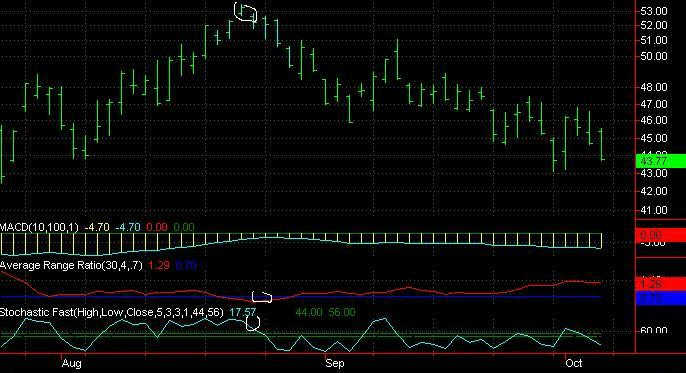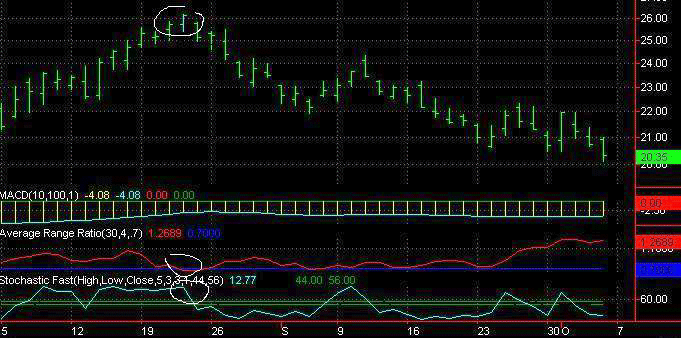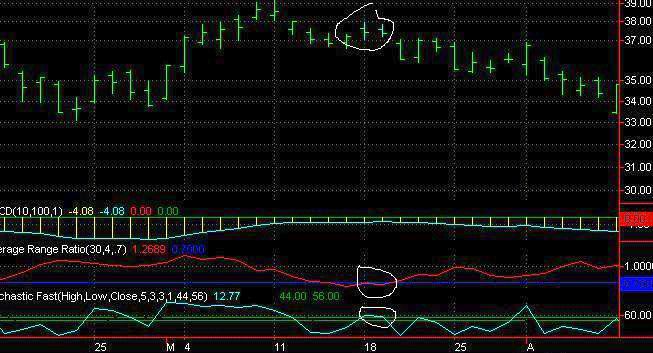Variations On Range Expansion
Linda Raschke, Larry Connors and Toby Crabel,
these names have become known for a myriad of trading innovations. Here I
would like to discuss the range expansion techniques that these trading greats
have spoken of. Their range expansion techniques use strategic components like:
-
NR4 Days (Narrowest range of the past four days -
NR7 Days (Narrowest range of the past seven days) -
NR7-2 (2 NR7 days in a row) -
Historical Volatility -
Historical Volatility Ratios
After using these components for some time, I began looking for some
alternatives to signal days where canned volatility is looking to pop out. Being
a short-term trader or swing trader, I look to enter and exit trades as quick as
possible. Alan Farley in The Master Swing trader said that range
contraction is the interface to range expansion; I agree with that statement. If
you add a layer of range contraction study to your technique you will find that
you can pick up quick winnings and get out ASAP.
I trade this strategy on daily charts, however I imagine it would be effective
on any time frame. For this setup we are looking for the following:
A trend
An overbought/ oversold condition
Range contractionÂ
To establish a trend you can read about the myriad of indicators, signs and
signals that could let you know if it exists or not. Mark Boucher’s 10 week
lesson has a great section on trend qualifiers, as does Dave Landry’s work all
over. Ultimately, I use MACD or ADX programmatically to establish a trend.
To establish an overbought or oversold condition, again there are many
mechanisms you could use. Programmatically I am using a 5 period fast stochastic
with 44 and 56 as the signal lines. Really I am just looking to see that a
market is NOT overbought if I am selling and NOT oversold if I am buying.
The main point of this article; to establishing range contraction we will use an
ATR Ratio; a short term ATR divided by a longer term ATR. Effectively what we
are saying is; the market’s true range is typically X and presently it is Y. If
the short term ATR is much smaller than the longer term ATR then we can see that
the current market is contracted. This gives us insight as to weather or not
range will be generally set to expand again. For this example I am using a 4
period ATR / a 30 period ATR and a .7 signal line. You can adjust these as you
will, however my testing has shown these values to be pretty effective.
Unlike most range contraction strategies, I am not looking to go long or short
based on the directional expansion. I am looking to follow the larger trend out
of it’s overbought/ oversold condition. As is common for range expansion
techniques I use an ATR multiple to enter this setup. I prefer to exit off of
the prior close, however you could apply whatever actual entry signal you like,
I am merely trying to display how the added layer of range contraction could
benefit a system. My exact entry technique buys or sells when price the price
moves .7 * the 8 day ATR. What this is saying effectively is; if the price moves
more than ½ of your 8 day average range in the direction of the major trend out
of a contraction, then we are expanding and reasserting so enter a trade.
These 3 fairly recent examples, 2 from the QQQ, 1 from the BBH show signals
generated by this method. Adding this layer of range contraction to your system
will surely generate fewer signals than without it, however it will also allow
you to be in the market for a short time period and out when you can be.
Other variations on this method include using just a ratio of a short term range
to a long term range (not ATR but plain range). I do prefer the ATR signal as
Average True range takes into consideration overnight gaps and the like to
establish a more accurate idea of range. I have, however, found similar results
with the range signal. I often will accept either an ATR Ratio signal or a Range
Ratio signal, as they generate similar but not always exactly the same signals
so accepting either or will give you a few more entry signals.



The main thing I like about this method is that it makes sense to me. Usually
the range is bigger than it has been lately. I bet it will go back to how it
usually is soon. Let’s capitalize now.
Good Luck and feel free to email me for any tradestation code for these
indicators at
chrisdonnan@hotmail.com.
My best,
Chris
Â
Chris Donnan lives in
Brooklyn, New York. He is a professional software engineer and an avid trader.
Â
